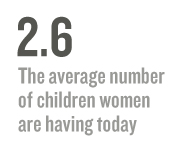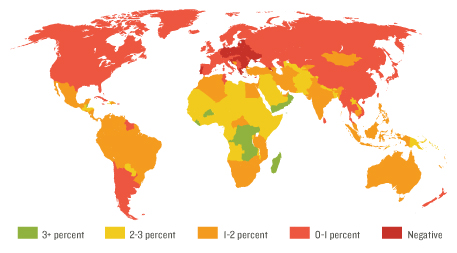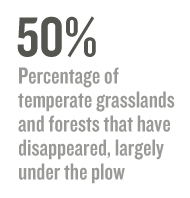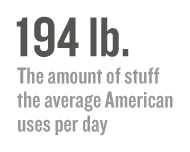March 24, 2013 — Two German shepherds kept as pets in Europe or the U.S. use more resources in a year than the average person living in Bangladesh. The world’s richest 500 million people produce half of global carbon dioxide emissions, while the poorest 3 billion emit just 7 percent. Industrial tree cutting is now responsible for the majority of the 13 million hectares of forest lost to fire or the blade each year — surpassing the smaller-scale footprints of subsistence farmers who leave behind long, narrow swaths of cleared land, so-called fish bones.
In fact, urban population growth and agricultural exports drive deforestation more than overall population growth, according to research from geographer Ruth DeFries of Columbia University and her colleagues. In other words, the increasing urbanization of the developing world — as well as an ongoing increase in consumption in the developed world for products that have an impact on forests, whether furniture, shoe leather or chicken fed on soy meal — is driving deforestation, rather than containing it as populations leave rural areas to concentrate in booming megalopolises.
The combination of increasing health, empowered women and falling birth rates may be the most important revolution to come out of the tumultuous 20th century.
So are the world’s environmental ills really a result of the burgeoning number of humans on the planet — growing by more than 150 people a minute and predicted by the United Nations to reach at least 9 billion people by 2050? Or are they more due to the fact that, while human population doubled in the past 50 years, we increased our use of resources fourfold?
Peak Humanity
 First and foremost, human population growth peaked long ago, according to demographer Joel Cohen of Rockefeller University in New York and others. The peak growth rate — a little more than 2 percent per year — occurred somewhere between 1965 and 1970, when the world’s population was just 3.3 billion people, and has been dropping ever since, reaching a little over 1 percent today. In 1987, the number of people added to the planet each year topped out at 87 million, a number that is now down to roughly 78 million people per year. That means human population numbers will drop voluntarily for the first time ever in human history in the 21st century. A Baby Bust has replaced the Baby Boom.
First and foremost, human population growth peaked long ago, according to demographer Joel Cohen of Rockefeller University in New York and others. The peak growth rate — a little more than 2 percent per year — occurred somewhere between 1965 and 1970, when the world’s population was just 3.3 billion people, and has been dropping ever since, reaching a little over 1 percent today. In 1987, the number of people added to the planet each year topped out at 87 million, a number that is now down to roughly 78 million people per year. That means human population numbers will drop voluntarily for the first time ever in human history in the 21st century. A Baby Bust has replaced the Baby Boom.
The reason? Empowerment of women. A massive reduction in child mortality, combined with educated mothers pursuing their own advancement and in control of birth control, has helped to drop the average human brood from over five children per woman of childbearing age to just 2.6 per woman today. As journalist Fred Pearce writes in his new book, The Coming Population Crash: “The population bomb is being defused. By women. Because they want to.”
In fact, the combination of increasing health (especially a greater proportion of babies surviving to adulthood), empowered women and falling birth rates may be the most important revolution to come out of the tumultuous 20th century. Those of us born between 1930 and 2050 will be among the privileged few to have ever witnessed a doubling of global population. It took from the dawn of humanity to the 19th century to achieve 1 billion people on the planet — an achievement that now comes roughly every few decades. And the 21st century will likely belong to the old, as elders outnumber youth for the first (recorded) time in human history: Fewer than 10 percent of people alive today are under 4 years old, while those 60 and older now constitute more than 10 percent of the population. Birth rates in countries such as Germany have fallen so far that populations are already shrinking.

POPULATION GROWTH RATE (2011) Births, deaths, immigration and emigration — all influenced by health, nutrition, education, prosperity and more — create different patterns of population change in different places. Source: World Bank.
Yet this demographic transition does not hold everywhere. While family planning has proven effective in the past in countries ranging from Thailand to Iran, funding for such programs has dwindled in recent years. Partially as a result, developing countries in eastern Africa — Kenya, Tanzania, Uganda and Zimbabwe — have seen populations begin to swell again in recent years.
Capacity Unknown
The real question is, how many people can the planet sustain? As Cohen notes in his book How Many People Can the Earth Support?, microbiologist Anton van Leeuwenhoek calculated a carrying capacity of roughly 13.4 billion people back in 1679, based on the population density of his native Holland and its size relative to the rest of the globe. Modern guesses are hardly more scientific, ranging from as few as 1 billion (recently proposed by James Lovelock as our likely number by 2100 thanks to catastrophic climate change) to as many as 1 trillion.
“These estimates are political numbers, intended to persuade people, one way or another: either that too many humans are already on Earth or that there is no problem with continuing rapid population growth,” Cohen writes.
As early as 1948, scientists began to link explosive modern population growth and catastrophe. Ornithologist William Vogt’s Road to Survival warned of impending demographic doom — as have numerous conservationists and environmentalists in the subsequent decades, perhaps most famously biologist Paul Ehrlich (The Population Bomb) or Donella and Dennis Meadows (The Limits to Growth). In Ehrlich’s case, observations of butterflies breeding so fast as to consume all available food — and then dwindling away — inspired him to predict the same fate for humans.
This is not a new idea, mind you. As early as 1600 B.C., when total population was less than 50 million, Babylonians worried that the world was too full of people, according to Cohen. The predicted human population of 2050 — 9 billion people — would have been inconceivable at that time.
Outpacing Pessimism
That’s because human ingenuity — whether through the waterworks of ancient Babylon or the more modern breeding of staple crops such as wheat for higher yields, known as the “Green Revolution” — has outpaced, so far, the pessimism of apocalyptic environmentalists.
Agronomist Norman Borlaug and colleagues created a strain of dwarf wheat that staved off famine for hundreds of millions in the 1960s and 1970s — increasing India’s harvest alone by nearly 170 percent in less than a decade. Yet “there can be no permanent progress in the battle against hunger until the agencies that fight for increased food production and those that fight for population control unite in a common effort,” Borlaug said in his acceptance speech for the Nobel Peace Prize in 1970. “[Man] is using his powers for increasing the rate and amount of food production. But he is not yet using adequately his potential for decreasing the rate of human reproduction. The result is that the rate of population increase exceeds the rate of increase in food production in some areas.”
That demographic contradiction is nowhere more true than in many countries of sub-Saharan Africa, where a population of 800 million must subsist on local yields of 1 metric ton per hectare — one-third of yields in the rest of the developing world and one-ninth those of the U.S., Europe, Australia and other parts of the developed world.
Genetic modification might boost yields. Such technology is “critical for achieving the ecological intensification required to meet human food demand on a global scale,” says agronomist Kenneth Cassman of the University of Nebraska–Lincoln. And genetic modification may prove critical to meet the challenge of crop stress due to climate change, dwindling topsoil and billions more mouths to feed. But it is illegal in most of Africa, according to political scientist Robert Paarlberg of Wellesley College, and faces serious public concern and regulatory challenges in the U.S., Europe and other parts of the world.
Still, there is still plenty of room for improvement by more conventional means: the targeted application of fertilizer and the like. The Earth Institute’s Millennium Village of Sauri in Kenya has tripled yields even in the face of a crippling drought gripping the region, and Malawi doubled yields through fertilizer subsidies in just four years.
Nor is the growth of human population an unmitigated ill. After all, more people means more minds and hands devoted to solving the pressing problems of increasing yields, biodiversity loss and economic sustainability — as can be seen in many portions of Africa today. As economist Ester Boserup argued in the 1960s: Population growth may drive agricultural innovation, from the plow to Borlaug’s dwarf wheat, rather than the other way around.
Ten Thousand Ton Child
 Yet apocalyptic biologists have a strong case as well. Fifty percent of all temperate grasslands and forests have disappeared, largely under the plow. More than 16,000 known species face extinction (785 have already been lost) and as many as 12,000 species unknown to science disappear each year, according to biologist E.O. Wilson of Harvard University. More than 90 percent of some commercial fish species, such as cod, pollock and haddock, are gone. Water tables around the globe plummet precipitously, thanks to human withdrawals for agriculture. And population growth to 9 billion people alone will add as much as 2 billion metric tons more of carbon dioxide to the greenhouse gas blanket smothering Earth.
Yet apocalyptic biologists have a strong case as well. Fifty percent of all temperate grasslands and forests have disappeared, largely under the plow. More than 16,000 known species face extinction (785 have already been lost) and as many as 12,000 species unknown to science disappear each year, according to biologist E.O. Wilson of Harvard University. More than 90 percent of some commercial fish species, such as cod, pollock and haddock, are gone. Water tables around the globe plummet precipitously, thanks to human withdrawals for agriculture. And population growth to 9 billion people alone will add as much as 2 billion metric tons more of carbon dioxide to the greenhouse gas blanket smothering Earth.
“The inexorable increase in human numbers is exhausting conventional energy supplies, accelerating environmental pollution and global warming, and providing an increasing number of failed states where civil unrest prevails,” writes reproductive biologist Roger Short of the University of Melbourne in the introduction to a special issue of Philosophical Transactions of the Royal Society B — a journal from the U.K.’s Royal Society whose motto is “Take nobody’s word for it.”
Short goes so far as to call for a halt to future population growth. After all, the most profound way a U.S. citizen can impact climate change is to have fewer children, since every American child born today will add almost 10,000 metric tons of CO2 to the atmosphere under current conditions — five times more than a Chinese child and 160 times more than a baby from Bangladesh. Having one fewer child would reduce a family’s greenhouse gas impact 20 times more than driving a Toyota Prius, using Energy Star appliances and other environmentally friendly lifestyle choices combined, according to researchers at Oregon State University.
Eating Away
But the real problem today — as it has been since at least the time of Thomas Malthus — may be food. Simply to maintain today’s number of chronically malnourished or outright starving people — 1 billion — in 2050 with a larger population and present crop yields would require clearing 900 million additional hectares of land. At most, there are an additional 100 million hectares to add to the 4.3 billion already under cultivation worldwide, according to Pedro Sanchez, director of the Tropical Agriculture and the Rural Environment Program at the Earth Institute.
Concerns about population growth often boil down to concerns about too many of the wrong sort of people.
“Agriculture is the main driver of most ecological problems,” says economist Jeffrey Sachs, director of the Earth Institute at Columbia University. “We are literally eating away the other species on the planet.” After all, humans now directly employ some 40 percent of the total land area of Earth.
Nor can the solution be found in the ongoing increase in nature reserves, which currently cover some 15 million square kilometers of the planet. “There are desperately poor people surrounding many of these reserves,” Ehrlich says. “If I was there, I would shoot the hippo and eat it too.”
Concerns about population growth often boil down to concerns about too many of the wrong sort of people, as evidenced by recent efforts to tie environmental and anti-immigration efforts, such as an unsuccessful bid by nativist John Tanton to turn the Sierra Club against immigration. After all, governments from France to Australia pay their citizens to have babies in an effort to ward off the baby bust — and those efforts seem to be working. Women in developed countries are having more children again, according to demographer Mikko Myrskylä of the University of Pennsylvania. “Increases in development are likely to reverse fertility declines — even if we cannot expect fertility to rise again above replacement levels,” Myrskylä writes in Nature. “We expect countries at the most advanced development stages to face a relatively stable population size.”
That does not include immigration, of course, which some environmentalists decry as a threat to the sustainable future of the U.S. Yet the U.S. has only 80 people per square mile compared with 140 per square mile in Mexico, to take just one example. Immigration may actually reduce environmental pressures elsewhere — such as Haiti, where 760 people live for every square mile of countryside. And immigration remains the single most effective poverty alleviation program on the planet, according to economist Lant Pritchett of Harvard University. He argues that labor (i.e., people) should be as free to move internationally as capital (i.e., money).
It’s the Consumption, Stupid
 Ultimately, the problem isn’t the number of people, necessarily. It’s what those people do. The average American (just one of 309 million) uses up some 194 pounds of stuff—food, water, plastics, metals and other things — per day, day in and day out. We consume a full 25 percent of the world’s energy despite representing just 5 percent of global population. And that consumerism is spreading, whether it be the adoption of cars as a lifestyle choice in China or gadget lust in the U.S.
Ultimately, the problem isn’t the number of people, necessarily. It’s what those people do. The average American (just one of 309 million) uses up some 194 pounds of stuff—food, water, plastics, metals and other things — per day, day in and day out. We consume a full 25 percent of the world’s energy despite representing just 5 percent of global population. And that consumerism is spreading, whether it be the adoption of cars as a lifestyle choice in China or gadget lust in the U.S.
“Consumerism is now spreading around the world,” says Erik Assadourian, a senior fellow at the Worldwatch Institute. “Is this going to keep spreading? Or are countries going to start recognizing that this is not a good path?”
What’s needed is the wholesale junking of the disposable life, Assadourian says, “a world where machismo is not connected to the size of a car but the fact that you don’t have one at all.” That may not be all our fault. “We are not stupid, we’re not ignorant, we don’t even necessarily have bad values with respect to the environment,” says political scientist Michael Maniates of Allegheny College. “We’re trying to do our best within cultural systems that elevate unsustainable choices.”
The world already grows enough food to feed 10 billion people — if we all ate a vegetarian diet, Cohen notes. Such lifestyle changes may prove unpalatable, transforming everything from how the dead get buried to gadgets that last a lifetime or more.
As simply put by the United Nations Millennium Ecosystem Assessment in 2005: “Human activity is putting such strain on the natural functions of Earth that the ability of the planet’s ecosystems to sustain future generations can no longer be taken for granted.” In other words, we just might let the world go to the dogs. ![]()
This article originally appeared in the Summer 2010 issue of Momentum magazine, Ensia’s predecessor.
Ensia shares solutions-focused stories free of charge through our online magazine and partner media. That means audiences around the world have ready access to stories that can — and do — help them shape a better future. If you value our work, please show your support today.
Yes, I'll support Ensia!

But what many advocates of lower consumption don’t realize is that the U.S. population is both consuming at an unsustainable pace and also growing at a historically pace unprecedented in the developed world.
In contrast, the countries of the European Union, which in 1980 had a combined population twice the size of the 225 million recorded in the 1980 U.S. Census, has grown by a modest 10% since then. The U.S., meanwhile, has grown by 40% in the same time frame, adding 90 million people to the largest and most wasteful society on the planet.
This pace is expected to continue even without the increases proposed by immigration reform, but the White House just released a “Fact Sheet” which claims that ““U.S. population growth is projected to fall almost in half over the next three decades.”
http://www.uspolicy.be/headline/white-house-fact-sheet-economics-immigration-reform
This is a dubious statement based on percentage of a rapidly growing whole, but it is flat-out false in regards to numerical growth, which reflects more accurately the climate impacts and the failures to maintain our infrastructure in keeping with this expansion.
For a more detailed analysis in video and text form, see
www.onethirdorunder.org
Global replacement rate is 2.33 children per woman.
USA = 2.4, UK = 1.7, Aus = 1.76 (2000-05), so telling people to "take responsibility" is really pointing the finger at the third world.
Claiming 'education' is the solution & presenting rich educated Indian girls wanting one child as evidence is ingenuine. Since only the well off can afford education, that evidence rather points to the effect of material security on family size.
Large families provide the only security the poor can achieve, risky as that strategy is for them. But their desperate need for security questions how the first world exploits the third world to provide the standard of living WE demand.
India uses 1.3ha of the earth / person - we use between 3 & 4 times that, but sustainability (and justice!) demands we reduce that to 2ha. It is more pleasant to focus on their ignorance, isn't it.
We should demolish the fraud being committed - we haven't got time to be going down wrong paths blaming the poor for the state of the planet or its future!
Selling an idea is often about telling enough truth to slip in the lie unnoticed from which you can profit.
Just thought I needed to say something.
Regrds
Chris Baulman
@landrights4all
earth's sustainability and our cooling population growth rate doesn't fix the damage caused by the influence we have on raising everyone else's footprint by bad example.
And how is it possible to not mention production since that too has been universally recognized as critical since the 1950. The personal act of consuming does not in and of itself have any environmental impact. Chomping down on on a burger doesn't kill a wolf. It is the production of cows that kills wolves. So while politically engaged enviromentalists have linked population, consumption and production for over 60 years, de-political pundits like to ignore production and focus on a fairly meaningless pseudo "debate" about consumption vs. population.
It's time we put false dichotomies and debates aside and focus on all three pillars of the human impact simultaneously.
Kieran Suckling
Center for Biological Diversity.
The fact that wealthier nations are generally nearer to replacement rate than poorer countries does not mean that all calls for "taking responsibility" are secretly aimed at poor nations. The impact of any nation is Population x Consumption x Production. Wealthier nations may have lower fertility levels, but they have higher consumption rates and, for many products, more damaging production systems. From this perspective, the U.S. is on the most overpopulated countries on earth. Thus not surprisingly, people are working on these issues in both wealthy and poorer countries. In the U.S., for example, 40% of all pregnancies are unplanned and access to family planning is under assault by reactionary state policies. There is much work to be done here, and many population, reproductive rights and human rights groups trying to improve things in the U.S.
It is well established that increased education, increased freedom and rights, and increased access to birth control--especially for women--is very effective at reducing fertility rates, improving economic conditions and increasing freedom from gender oppression. This is not just a matter of the high level of education you seem to be referring to that is largely out of reach to poor people. Better education and gender equality are possible for and relevant to all people, regardless of their economic situation. There are many groups and nations working on both in very poor communities with very limited education systems.
Kieran Suckling
Executive Director
Center for Biological Diversity
USA is locked into consumerism - that is the problem.
It's also ridiculous to refer to unwanted pregnancies in the context of the sustainability of a population size. The population of USA is growing because of immigration, not pregnancies - pregnancy is happening at lower than relacement rates, wanted or not! The problem is consumerism & the example it sets for the rest of the world. Until we name the real demon we will continue to look for solutions in the wrong places.
Education is upheld as the way forward, but it has led to consumerism because of the system it operates in & upholds. Women know where babies come from - they don't need education for that. To choose to have smaller families they need other ways to security than a big family - no, not education in consumerism - just their RIGHTFUL access to a SECURE place to be.
In the capitalist model, this involves education to be able to compete successfully enough to buy a home - and that requires compliance with the consumer economy. Why? Because "the system" has stolen our birthright to land & we can only get secure access again by conforming.
That evil requirement to conform to consumerism is at the root of our environmental issues & many of our social issues too.
Technology won't save us from greed - it has always been used to increase consumption. Get solar cars & there will be more production of cars - & highways etc etc.
There is another way - a more attractive way for the vast majority who are looking for a way to escape poverty. But "overpopulationists" have their eyes firmly shut & ears plugged.